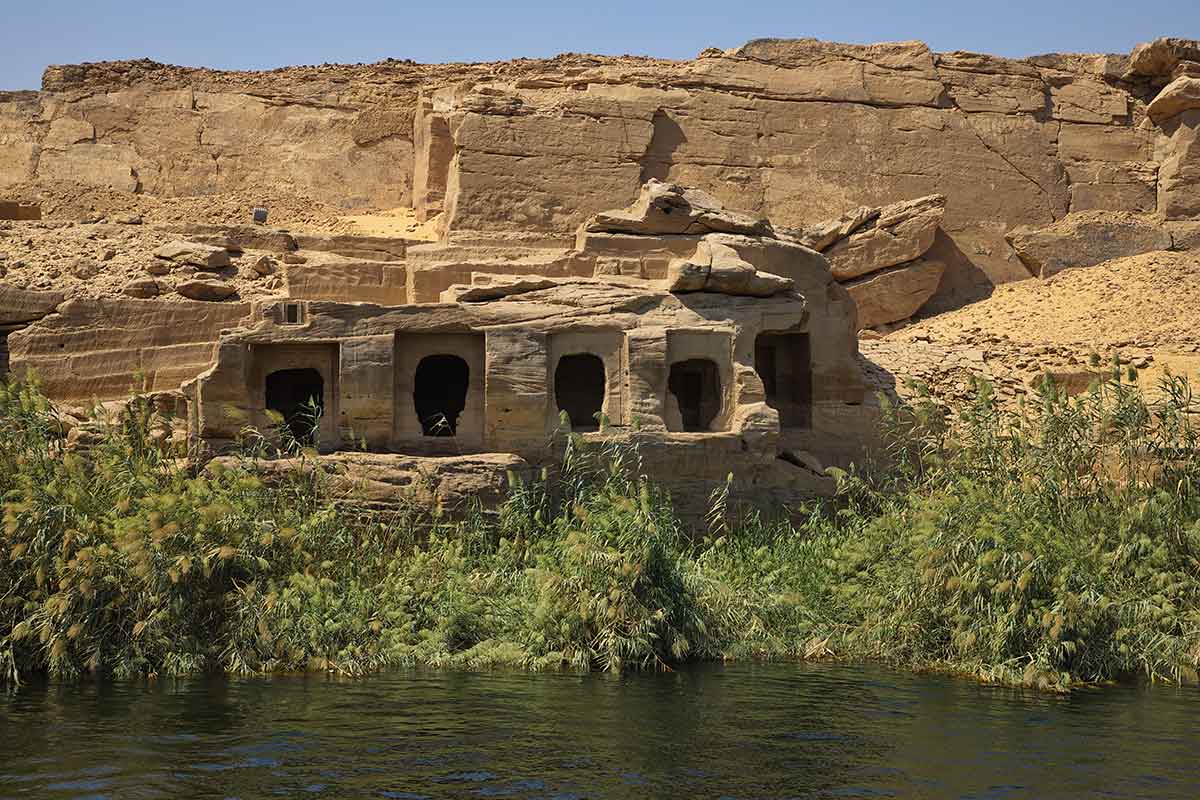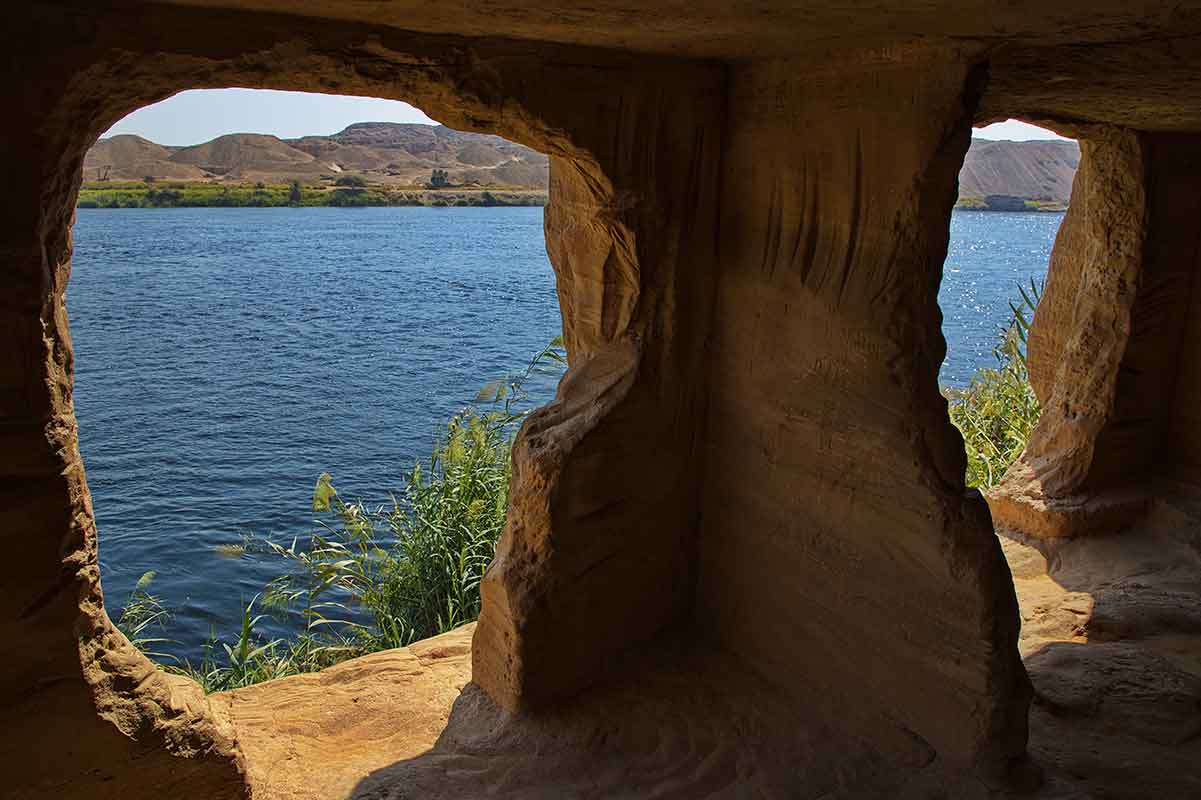Gebel el Silsila, también llamado Gebel Silsila, Gebel Silsileh o simplemente ElselseLah, es un yacimiento del Antiguo Egipto que ofrece un atractivo especial para quienes lo visitan: recibe muy pocos visitantes al día, principalmente porque no es fácil acceder a él, como veremos más abajo. Por ello, quienes llegan hasta aquí lo disfrutan casi en soledad y en silencio. Y eso, unido al bonito paisaje fluvial que lo circunda, le confiere un encanto excepcional.
Si estás interesado en visitar Gebel Silsila, en esta página te contamos cómo puedes hacerlo y te ofrecemos información general y práctica para ir tomando contacto con él. Y recuerda que para que todo salga según lo previsto, debes planificar el viaje con una agencia de confianza, como la nuestra. ¡Egipto Exclusivo estará a la altura de tus expectativas!
Gebel el Silsila se encuentra a unos 20 km al norte de Kom Ombo y a unos 60 km al norte de Aswan. Más lejos queda Luxor, pues este lugar se emplaza a unos 150 km al sur de esa ciudad. Forma parte de la Gobernación de Aswan y las poblaciones más cercanas son Al Madiq, Kalabsah y Al Kajuj, ambas en la orilla oriental del Nilo.
Su ubicación geográfica es bastante singular: la fértil vega del Nilo, de varios kilómetros de ancho al norte y al sur de este punto, se interrumpe abruptamente aquí, pues sobre las dos orillas se yerguen rocosos acantilados que hacen impracticable la agricultura.
Sin embargo,la importancia de Gebel Silsila en el Antiguo Egipto radica en que se usó como taller de escultura al principio y como cantera más adelante, en época romana. Estos acantilados rocosos proporcionaron bloques de piedra arenisca de la mejor calidad, y por ello se emplearon en algunos de los monumentos más majestuosos de aquel periodo. Por ejemplo, los Colosos de Memnón, en Luxor. Su situación junto al río Nilo era una ventaja, pues facilitaba el transporte de esos bloques, pero las propiedades de la roca le valieron igualmente una gran reputación, especialmente en tiempos del Imperio Medio y el Imperio Nuevo.
Este uso minero se desarrolló en ambas orillas, con más intensidad en la oriental, aunque en la occidental se encuentran los principales templos que han llegado hasta nosotros. Y es ahí donde se permanece la mayor parte del tiempo de las visitas que se organizan a Gebel el Silsila.
Su explotación cayó con el fin de la antigua civilización egipcia y no se redescubrió hasta comienzos del siglo XX, aunque ya había conocimiento de su existencia desde la centuria anterior. Los primeros trabajos de investigación profunda sobre este lugar se publicaron a partir de los años 60. Por tanto, su interés ha ido de la mano de los cruceros por el Nilo: estos paquetes turísticos ganaron popularidad desde la construcción de la Presa Alta de Aswan, que permitió el control permanente del cauce de este gran río.
Sin embargo, los trabajos arqueológicos no se han detenido aquí y en las últimas décadas se han producido descubrimientos que poco a poco se van integrando en las visitas a Gebel Silsila. Uno de los últimos ejemplos fue el hallazgo de una esfinge con cabeza de carnero que representa al dios Amón y data de tiempos de Amenofis III (Dinastía XVIII, Imperio Nuevo).

Los lugares que ver en Gebel Silsila se concentran muy cerca de sus orillas, sobre todo en la occidental. Son principalmente construcciones religiosas excavadas en la roca, con tipología de speos, que conservan elementos decorativos y estructurales de gran interés, especialmente porque su ubicación junto al río amplifica su belleza. Sin embargo, también tiene encanto su contemplación nocturna, pues permanecen iluminados para que puedan ser vistos desde las embarcaciones que navegan o atracan aquí tras la puesta de sol.
Esta concentración de templos demuestra que, además de su importancia como cantera, Gebel el Silsila también debió de ser un lugar de referencia a nivel religioso. No obstante, muchos de estos templos están mutilados y en ruinas porque sus bloques fueron reutilizados en diversos periodos, especialmente durante el Periodo de Amarna bajo el reinado de Akhenaton. Estos son los más destacados.
Es probablemente el más interesante. Situado en la orilla occidental y construido en tiempos de este faraón de la Dinastía XVIII, está consagrado a varias deidades. En su decoración hay escenas de monarcas realizando ofrendas a los dioses, tanto en el exterior como en su interior. Es la construcción más grande de Gebel el Silsila y de hecho cuenta en su estructura con dos capillas destacables: la de Panehesy y la de Paser.
Fue probablemente el templo principal de la orilla oriental, aunque en la actualidad apenas se conservan los cimientos de lo que fue aquella construcción. Como indica su nombre, estuvo dedicado a Sobek, este último el ‘dios cocodrilo’, de gran veneración en estas tierras como puede comprobarse en la cercana Kom Ombo.

Para viajar a Gebel Silsila hay una opción de transporte que se impone a todas: el barco, por medio de cruceros por el Nilo. Y en concreto, en pequeñas embarcaciones a vela, ya sean diahabiyas o falucas, que son las que pueden atracan en los muelles situados junto al yacimiento. En cambio, a las grandes motonaves no les está permitido hacerlo y sus pasajeros se tienen que conformar con ver el monumento de pasada mientras navegan por delante.
Estas embarcaciones son de pequeñas dimensiones pero, no obstante, cuentan con todas las comodidades a bordo. Puedes contactar con Egipto Exclusivo para más información, pues nuestra agencia ofrece paquetes de muy diverso tipo.
Además del barco, está la opción de viajar hasta Gebel Silsila en coche. Sin embargo, tendrás que hacerlo necesariamente con un vehículo privado, a ser posible con un conductor profesional y local, puesto que no es fácil llegar hasta este yacimiento: hay que tomar un desvío de la carretera de Aswan-Giza, a las afueras de Nagaa El-Hamam.
El autobús público, en cambio, no es una opción viable, pues ninguna gran empresa turística organiza viajes hasta aquí. Y el tren solo servirá para acercarte hasta los alrededores de Gebel Silsila, puesto que la estación de ferrocarril más cercana es Klasbha, a unos 3 km de aquí. En cualquier caso, se trata de una estación muy pequeña que no recibe tráfico de turistas, por lo que tampoco será la opción más cómoda y recomendable.
En resumen: si tu deseo es visitar Gebel el Silsila, viajando de forma segura y cómoda sin perder detalle del yacimiento, tu solución pasa por Egipto Exclusivo: nos encargaremos de reservar tu crucero por el Nilo con parada aquí o bien proporcionarte un vehículo privado con conductor para que te desplaces desde Aswan o cualquier otra ciudad.


Fill out the form below to receive a free, no-obligation, tailor-made quote from an agency specialized in Egypt.
Travel agency and DMC specializing in private and tailor-made trips to Egypt.
Mandala Tours, S.L, NIF: B51037471
License: C.I.AN-187782-3